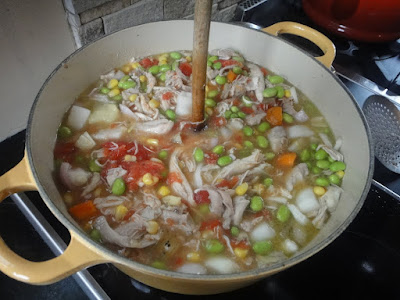
Here it is - my first Daring Cooks Challenge post! (a little late because of my Asian travels). If you don't know about
The Daring Kitchen, be sure to check it out - foodies from all over the world sharing their love of food, recipes, tips and - once a month - cooking (or baking) the same thing.
The 2010 April Daring Cooks challenge was hosted by Wolf of
Wolf’s Den. She chose to challenge Daring Cooks to make Brunswick Stew. Wolf chose recipes for her challenge from The Lee Bros. Southern Cookbook by Matt Lee and Ted Lee, and from the Callaway, Virginia Ruritan Club. I used the Lee Bros. version and modified the recipe by using edamame beans instead of butter beans, all chicken thighs instead a chicken pieces and white wine to deglaze the pot. Try it, y'all - it's divine!
Brunswick Stew
adapted from The Lee Bros. Southern Cookbook: Stories and Recipes for Southerners and Would-Be Southerners, by
Matt Lee and Ted Lee
serves 6 generously
⅛ lb slab bacon, rough diced
1 Serrano or Thai fresh chili, stem trimmed, sliced, seeded, flattened
1 lb rabbit loin pieces
3 lb boneless skinless chicken thighs
½ tbsp sea salt for seasoning, plus extra to taste
1 cup dry white wine
6-8 cups
Sunday Chicken Broth (recipe below), or low sodium chicken broth
1 bay leaf
1 large celery stalk
1 lb
bintje potatoes, or other waxy type potatoes, peeled, rough diced
¾ cups carrots, chopped
1¾ cups onion, chopped
1 cup fresh or frozen corn kernels
1½ cups shelled edamame beans, defrosted if frozen
1 19 oz can whole, peeled tomatoes, drained and cut into small pieces (approx. 2 cups)
⅛ cup red wine vinegar
Juice of 1 lemon
Tabasco sauce to taste
1. In a large stockpot or Dutch oven, fry the bacon over medium-high heat until it just starts to crisp. Transfer to a large bowl, and set aside. Add the chili to the bacon fat in the pot. Toast the chili until it becomes fragrant, about a minute. Remove to bowl with the bacon.
2. Season the rabbit and chicken liberally on both sides with sea salt and pepper. Place the rabbit pieces in the pot and sear on all sides, until just browned, and add to the bowl with bacon and chili. Brown chicken thighs, adding more fat if needed, on all sides. Put the chicken in the bowl with the bacon, chiles and rabbit, and set aside.
Rabbit loins browning in bacon fat
3. Add the white wine to the pot and deglaze the pan, scraping up the browned bits from the bottom. Bring to a boil and reduce by half. Add 6 cups of stock, the bay leaf, celery, potatoes, chicken, rabbit, bacon, chili and any liquid that may have gathered at the bottom of the bowl they were resting in. Bring the pot back up to a rolling boil, over medium-high heat. Reduce heat to low and cover. Simmer for approximately 1½ hours, stirring every 15 minutes.
4. With a pair of tongs, carefully remove the chicken and rabbit pieces to a colander over the bowl you used earlier. Remove the bay leaf, celery and chili and discard. After you’ve allowed the meat to cool enough to handle, carefully remove all the meat from the bones, shredding it as you go. Return the meat to the pot.
5. Add the carrots, and stir gently, allowing it to come back to a slow simmer. Simmer gently, uncovered, for at least 25 minutes, or until the carrots have started to soften.
6. Add onion, edamame, corn and tomatoes. Simmer for another 30 minutes, stirring every so often until the stew has reduced slightly, and onions, corn and beans are tender. Remove from heat and add in vinegar, lemon juice; stir to blend well. Season to taste with sea salt, pepper, and Tabasco sauce if desired. It's so thick and delicious that a spoon will stand up in the stew on its own.
Look Ma, no hands
7. You can either serve the stew immediately or refrigerate for 24 hours, which makes the flavors meld more and makes the overall stew even better. Serve hot, either on its own, or with a side of corn bread, over steamed white rice, with any braised greens as a side.
Sunday Chicken Broth
from The Lee Bros. Southern Cookbook: Stories and Recipes for Southerners and Would-Be Southerners, by Matt Lee and Ted Lee
Makes about 1 quart
Bones and trimmings, but not giblets, of one 3 ½- 4 ½ lb, or 12-14 oz (approx. 2 cups) chicken bones and trimmings
1 large onion, trimmed, peeled, quartered
6 large stems fresh flat leaf parsley
1 stalk celery, cut into 2” lengths
2 large bay leaves
5 cups cold water
1 cup crisp dry white wine
Salt and pepper to taste
1. Place bones/trimmings in medium stockpot and add onion, parsley, celery and bay leaves. Add wine and water; liquid should cover all ingredients, if not, add more until it does. Bring to vigorous simmer over high heat, then reduce heat and simmer gently for roughly 45 minutes to an hour, skimming any scum or fat that comes to the surface.
2. Strain broth into bowl through fine mesh strainer. Discard the solids. Salt and pepper to taste.
3. Store in tightly sealed container in refrigerator until the remaining fat congeals on the top. Remove the fat, and unless not using within 2 days, keep tightly sealed in the refrigerator. Otherwise, freeze, and it will keep for upwards of a month.































































